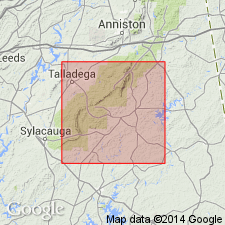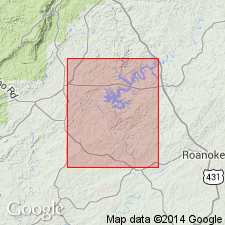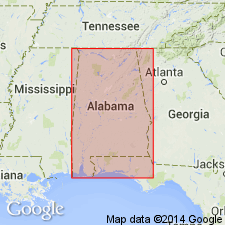
- Usage in publication:
-
- Bluff Springs granite
- Modifications:
-
- Named
- Dominant lithology:
-
- Granite
- AAPG geologic province:
-
- Piedmont-Blue Ridge province
Summary:
Intrusive biotite granite of same character as Pinckneyville granite, exposed in southeastern part of Clay Co., is locally designated the Bluff Springs granite. Reaches a maximum width a little north of Bluff Springs. [Name does not appear on accompanying map. This biotite granite is mapped everywhere as Pinckneyville granite. Neither is name Bluff Springs used by G.I. Adams on the 1926 Alabama Geological Survey Map of AL. Therefore, name is considered abandoned (M.G. Wilmarth, 1938, US geologic names lexicon, USGS Bull. 896).]
Source: GNU records (USGS DDS-6; Reston GNULEX).

- Usage in publication:
-
- Bluff Springs Granite
- Modifications:
-
- Reinstated
- Overview
- AAPG geologic province:
-
- Piedmont-Blue Ridge province
Summary:
Bluff Springs Granite used in this report and others by Neathery and Reynolds (1973) and Neathery and Tull (1975). Bluff Springs intrudes the Wedowee Group. Consists of light gray to white granite, ranging from quartz monzonite to trondhjemite. Only a generalized age of Precambrian to late Paleozoic is given.
Source: GNU records (USGS DDS-6; Reston GNULEX).

- Usage in publication:
-
- Bluff Springs Granite
- Modifications:
-
- Geochronologic dating
- Age modified
- AAPG geologic province:
-
- Piedmont-Blue Ridge province
Summary:
Bluff Springs is associated with metasediments of the Wedowee Group in Clay Co., east-central AL. Includes several lithologies with varying development of metamorphic textures. From zircons, has been dated tentatively at 366+/-21 Ma (Devonian to Mississippian).
Source: GNU records (USGS DDS-6; Reston GNULEX).

- Usage in publication:
-
- Bluff Springs Granite
- Modifications:
-
- Overview
- AAPG geologic province:
-
- Piedmont-Blue Ridge province
Summary:
Briefly described as medium-grained, locally foliated leucocratic quartz diorite to quartz monzonite and tonalite. Occurs in Northern Piedmont of AL. Age generalized as Precambrian to Paleozoic.
Source: GNU records (USGS DDS-6; Reston GNULEX).
For more information, please contact Nancy Stamm, Geologic Names Committee Secretary.
Asterisk (*) indicates published by U.S. Geological Survey authors.
"No current usage" (†) implies that a name has been abandoned or has fallen into disuse. Former usage and, if known, replacement name given in parentheses ( ).
Slash (/) indicates name conflicts with nomenclatural guidelines (CSN, 1933; ACSN, 1961, 1970; NACSN, 1983, 2005, 2021). May be explained within brackets ([ ]).

